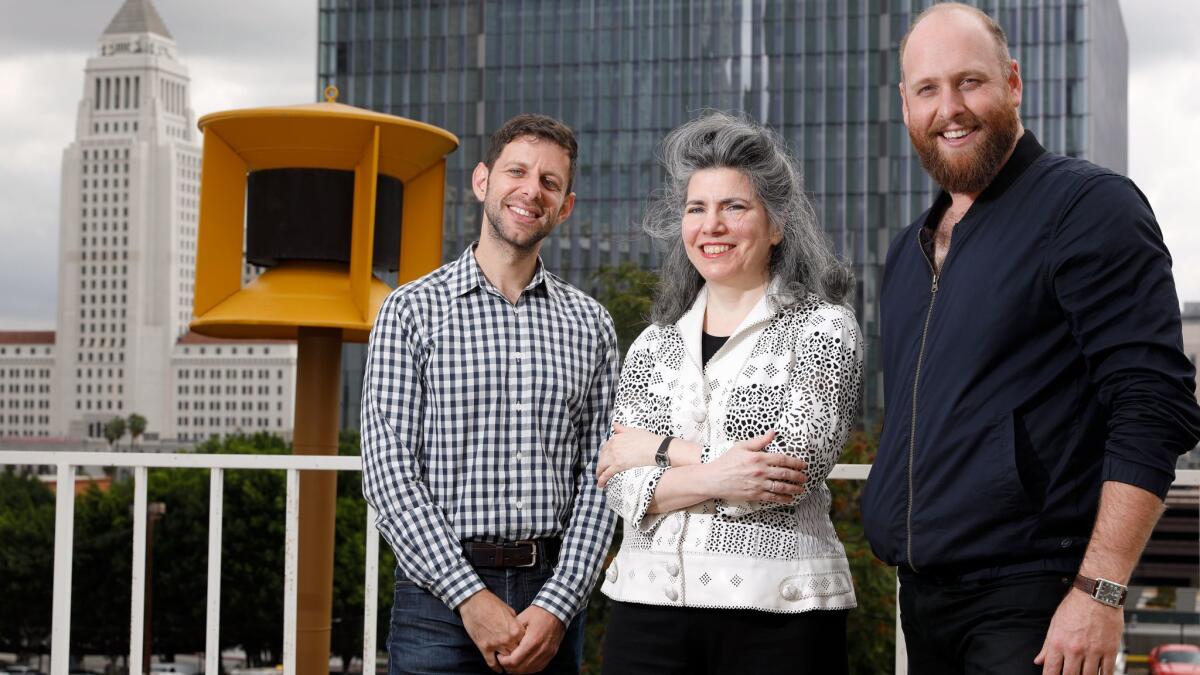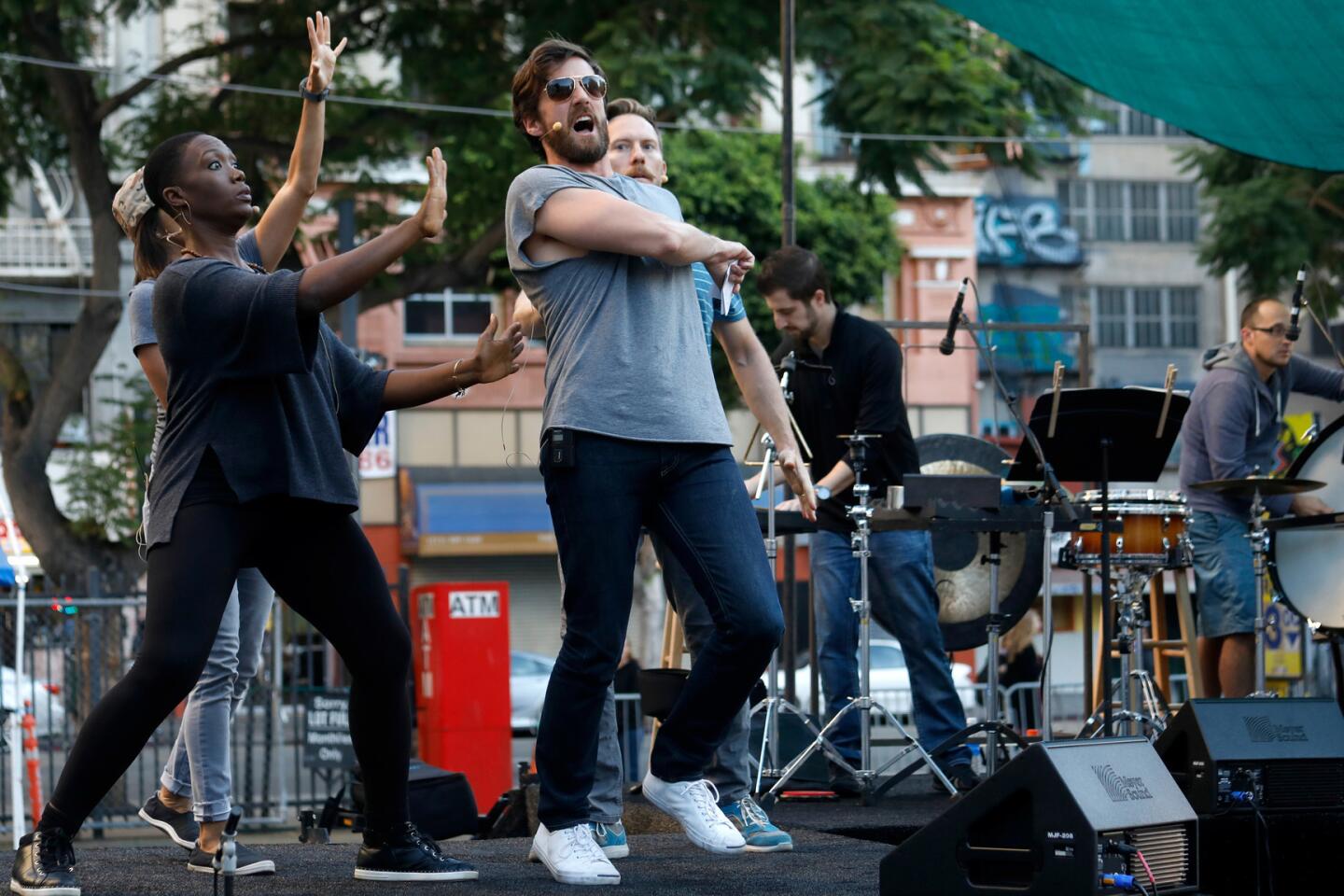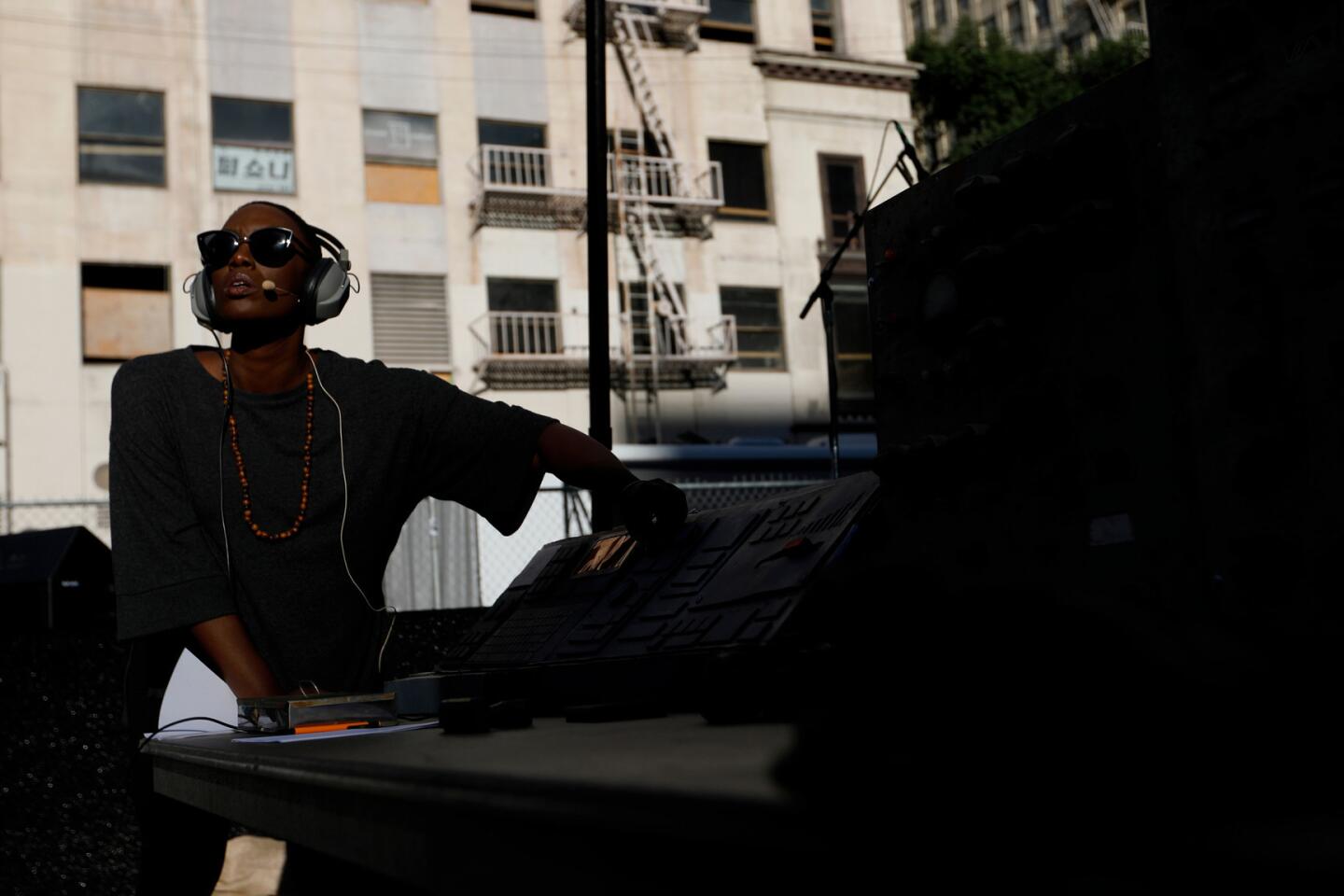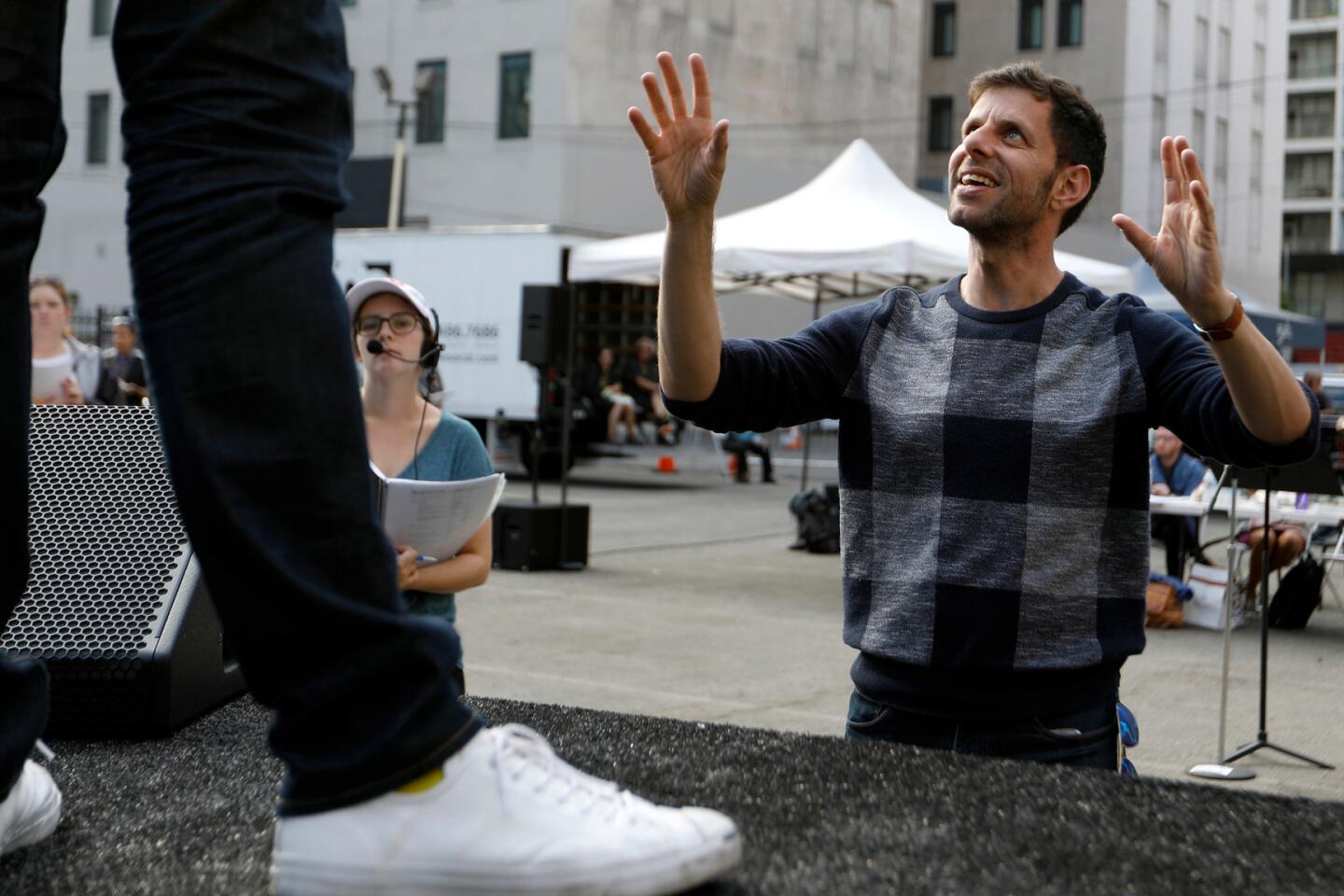‘War of the Worlds’ to invade Disney Hall and the streets of downtown L.A.

- Share via
A wiry orange alien scuttles across a cracked parking lot near the corner of 4th and Main streets downtown. The creature towers over the acting secretary of the Interior, who stands before a microphone broadcasting a somber statement to the public.
“Citizens of the nation, I shall not try to conceal the gravity of the situation that confronts the country,” she says as a two musicians saw away on a violin and an upright bass, a mustard-yellow air raid siren behind her rising above the chaotic scene.
A conductor vocalizes the sound of an alarm, and it’s a wrap. This weekend rehearsal for Annie Gosfield’s new opera, “War of the Worlds,” is over.
The ambitious performance piece, staging its world premiere Sunday, is the Los Angeles Philharmonic’s take on Orson Welles’ famous 1938 fake radio news broadcast about a Martian invasion of Earth. The text has been adapted by 2017 MacArthur fellow Yuval Sharon, who also is directing.
Part of what we hope to achieve with our audience is that they realize the value of their own critical faculties in assessing what’s true and what’s fabricated
— Yuval Sharon
Sigourney Weaver stars as the emcee of a concert at Walt Disney Concert Hall that gets interrupted by news of the invasion. Refurbished World War II air raid sirens at three outdoor sites are key to the action. They will transmit the percussive sounds of the aliens along with music and reports from inside Disney Hall. Sounds and news from the siren sites will in turn be broadcast into the hall.
Crackling radio music from long-ago ballrooms influenced Gosfield’s interplanetary compositions, which play with time and space via radio transmissions and the analog musicianship of the L.A. Phil.
At the core of the performance is the country’s troubled relationship with truth.
“Part of what we hope to achieve with our audience is that they realize the value of their own critical faculties in assessing what’s true and what’s fabricated,” Sharon says a few days later over coffee at the concert hall cafe with Christopher Rountree, who’s conducting, and Gosfield. Sharon adds that Welles used the original “War of the Worlds” broadcast, which sowed panic in some listeners, to explore radio’s potential as a tool of manipulation.
The collaborators say they found extra salience in their subject matter after allegations that a Russian disinformation campaign may have helped President Trump to victory in the 2016 election. The rise of the terms “fake news,” “alternative facts” and “post-truth,” as well as a feeling that the country is split when it comes to political and cultural perceptions, also feeds directly into the work, they said.
“I feel like it’s mandatory for us to engage in politics,” Rountree said emphatically, rattling off statistics about Russian election meddling on social media: 126 million Facebook users reached by inflammatory posts, 131,000 messages published on Twitter, more than 1,000 videos uploaded to YouTube. At the time of the election, Rountree says, people didn’t have knowledge of the scale of propaganda the country was dealing with.
“Now, it’s posts, not posters,” Sharon said, comparing the way propaganda is disseminated in the modern age as opposed to before World War II. “It’s just found its new medium.”
Sharon and company made a calculated choice not to use a new medium for their version of “War of the Worlds,” opting instead for the strikingly analog world of radio. They hope that this, along with the absurdity and levity in the script, will function as distancing devices, giving the audience space to meditate on the nature of truth and manipulation — and to arrive at the possibility of change.
“Personal expression is so important, and maybe a project like this inspires someone to voice an opinion artistically or politically that they wouldn’t otherwise,” said Gosfield, who lived in L.A. in the 1980s and remembers noticing the air raid sirens around town. Nearly 200 of the oxidized metal relics have been scattered about the metropolis since World War II. They are part of a skyscape most passersby don’t notice, but Gosfield became obsessed.
When Sharon approached her more than a year ago in his role as artist collaborator for the L.A. Phil, wanting to commission an opera using the sirens as central set pieces, she was all in. So were street artist Calder Greenwood and the public-art organization Now Art L.A., which produced wild art installations at the siren sites conjuring the destruction of the alien invasion, as well as the aliens themselves. Audience members can reserve spots at these sites free of charge and, of course, anybody who happens to be walking past during “War of the Worlds” will get in on the action too.
Activating the life of the street in service of the performance was important to Sharon, who has made a name as the artistic director of the experimental opera company the Industry. Its multimedia feats of derring-do include 2016’s “Hopscotch,” which took place in 24 cars rolling through the streets of L.A.
For Sharon, “War of the Worlds” has evolved into an institutional critique of classical music. The idea that music unfolds in the protected realm of a concert hall on Bunker Hill with no connection to life outside is worthy of challenging, he says, especially in times of crisis. After the election, he found himself wondering, as an artist, if there wasn’t something more important he should be doing.
“Why are we all sitting here in this concert hall together?” he asked himself. “That’s not to undercut the value of going to a Beethoven or Bach concert and it reminding you of the humanistic values that we all share, but there’s the danger of that becoming a kind of opium.”
People tend to think that the values espoused by the great masters are unassailable, Sharon says, “And because of that, the passivity with which we sit in a concert becomes the attitude with which we approach our daily lives.”
Audience members inside Disney Hall during “War of the Worlds” will be asked to take an active role when it comes to perception. Stretches of time will pass during which the only sounds concertgoers will hear will come from the world outside the hall.
“It’s the first time we have done something this grand or ambitious or beautifully foolish,” Rountree says of the L.A. Phil production.
During the rehearsal, Rountree waves his hands in the crisp fall air with the sun on his face, wearing black jeans, sneakers and a T-shirt — a far cry from his usual tuxedo-clad public persona inside Disney Hall. He smiled as a black SUV rigged with a camera for shooting a movie drove past the string players on Main Street. A police escort followed and the peal of an ambulance siren erupted somewhere in the distance. Meanwhile, a crew of workers affixed a vintage Italian deli sign over the Chao Chao Vietnamese Kitchen sign across the street, preparing for the film shoot.
“Can they please do that during the show?” Sharon asks, laughing. “That’s amazing. How do you describe that?”
“War of the Worlds” comes close, adding as it does to the rich layers of fact, fantasy and fiction that collide like old friends on the streets of Los Angeles.
♦ ♦ ♦ ♦ ♦ ♦ ♦ ♦ ♦ ♦
‘War of the Worlds’
Where: Walt Disney Concert Hall, 111 S. Grand Ave., as well as at three siren sites to be disclosed with an online reservation
When: 2 p.m. Sunday, noon and 2 p.m. Nov. 18.
Price: $21 and up for Sunday, $31 and up for Nov. 18 (includes admission to the L.A. Phil’s Noon to Midnight event); siren sites are free with reservation
Info: (323) 850-2000, www.laphil.com
ALSO:
More to Read
The biggest entertainment stories
Get our big stories about Hollywood, film, television, music, arts, culture and more right in your inbox as soon as they publish.
You may occasionally receive promotional content from the Los Angeles Times.

















